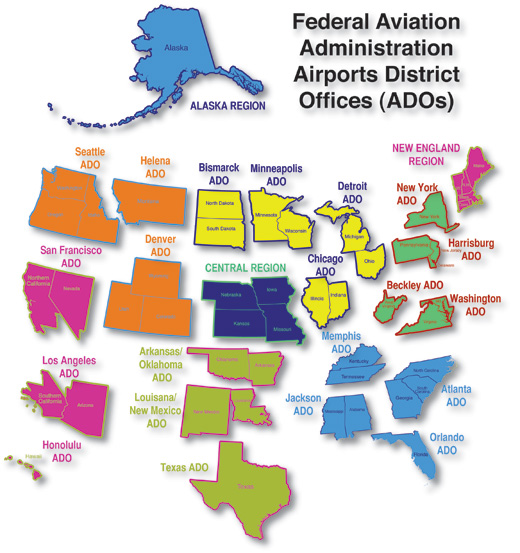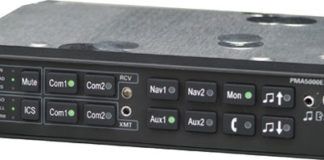I’ve only officially been based at two airports. The first one was a wonderful little airstrip down in the Mississippi flood plain across from St. Louis, Missouri. Unfortunately, it was flooded by the biannual “100-year flood” of 1993, along with the nearby town and several airports in the region. As a result, I was convinced that I should seek higher ground.

When dealing with airport issues, it is best to contact the Airports Division of your FAA Regional or Airports District Office.
I train people to fly powered parachutes, so I was looking for both a suitable airport and enlightened airport management. Many people pointed me in the direction of Greenville Municipal Airport (GRE) in Greenville, Illinois, where I have remained to this day. The reason people recommended GRE was the airport manager. The airport supported all kinds of aircraft operations, such as skydiving and ultralighting, and the manager himself owned a hot air balloon in addition to his airplanes. I had found my little slice of paradise.
When that airport manager retired, paradise was at risk of being lost. I knew I was in for rough sledding when the new manager informed me that, “Airports are for airplanes.” Luckily, the rough patch lasted only a year. That manager was replaced by one who works hard to include all segments of aviation.
As it turns out, bad attitudes are not as rare as one might hope. Airports can become as tribal as other human affairs, with groups forming to compete for limited resources. “What kind of resources?” you might ask. Certainly at the top of the list is hangar space. After all, most airports seem to have a longer list of people wanting hangars than they have hangars. But there are other resources such as room in the pattern, reputation and even petty things such as parking spaces. Not to mention that many people view their airports as akin to country clubs. Experimentals, ultralights, gyroplanes, trikes, powered parachutes and the like are sometimes frowned on by some general aviation (GA) pilots.
Management may share the concerns of its GA airport denizens, but it also has profit concerns. If you fly an ultralight, you will be using less fuel, and it probably won’t be the 100 LL sold at the airport. That means if the airport rents one of its hangars to you, management will see little to no back-end to the transaction when it comes time for you to fuel up.
Management also doesn’t necessarily enjoy accommodating anything beyond the run-of-the-mill GA airplane in “their” patterns. Gyroplanes, ultralights and ultralight-like aircraft normally fly different patterns to avoid GA traffic. Some airport managers believe that the different patterns are being flown because the pilots are somehow uneducated. Others don’t want to work out safe new ways to address airport traffic.
Our Own Worst Enemy
Sometimes, though, airport managers develop an anti-ultralight prejudice through experience. There are plenty of times when a group of non-conventional pilots have flown extra non-conventionally, often through ignorance of airport traffic patterns or simply because they don’t care. The way to really get under an airport manager’s skin is to fly unsafely, or in a manner perceived as unsafe. Not only are you irritating them, those managers are going to be fielding complaints from the rest of the pilots at the airport.
If an airport has had a bad experience with, say, a group of powered parachute pilots, it’s a natural reaction to ban the category of aircraft rather than focus on the bad apples, even though they may be long gone. It’s important that we be good ambassadors for the sport, so future enthusiasts don’t suffer for our mistakes.
No Welcome Mat
As a United States Ultralight Association (USUA) board member and a recognized name in the industry, I regularly field calls relating to public airport access issues. (The emphasis on public airports; we all understand that private airports can make up their own rules because ownership is, by definition, private.) Problems arise when public airports behave as though they were private airports. This past year, pilots have contacted me with numerous complaints of airports trying to restrict access to their ultralights or ultralight-like aircraft. For example:
Telling ultralight owners they are banned from the facility.
Telling ultralight owners that they cannot rent hangar space.
Demanding insurance coverage from ultralight owners renting hangar space.
Demanding that ultralight pilots fly the same pattern as GA aircraft.
The only valid demand in the list is the third, and only if airport management demands the same level of insurance from all hangar renters at the airport.
United States Code, Title 49, Subtitle VII, Part B, Subchapter I, §47107
You won’t find §47107 in your FAR/AIM, but aside from your winning smile, it may be your best tool to gain access to a recalcitrant public airport. Section 47107 is better known as a “Project grant application approval conditioned on assurances about airport operations,” and nearly all public airports in the country have applied for and accepted federal funds (and the requirements of this section) to establish or improve their facilities.
This section of the U.S. Code requires that before a project grant application is approved, the airport must provide a series of written assurances to the federal government. The list of assurances go on for more than 5000 words, but those of interest to us are at the top of the list.
(a)General Written Assurances.—The Secretary of Transportation may approve a project grant application under this subchapter for an airport development project only if the Secretary receives written assurances, satisfactory to the Secretary, that:
(1)the airport will be available for public use on reasonable conditions and without unjust discrimination.
Unjust discrimination covers a lot of ground, including discriminating against categories of aircraft or their pilots. Many managers are unaware of their obligation under §47107, and some will pretend that it doesn’t exist. But oftentimes gently asking the question, “Does this airport take federal funds?” will alert the manager that you aren’t ready to give up.
The written assurances document prevents airports from banning ultralights outright, so sometimes management will try slightly more devious techniques. One is declaring ultralights dangerous and a safety concern. Of course, the FAA takes safety issues very seriously, but also knows well enough that ultralights and Experimentals can coexist with GA and commercial aircraft at airports. In any case, if an airport wants to pursue that angle, it is not as simple as having a local meeting and voting to ban an aircraft category. Airport officials are required to work through the FAA, which has probably funded up to 90% of the airport infrastructure. The FAA is going to encourage them to work out procedures for the aircraft in question rather than rubber-stamping a ban. Bear in mind this does not mean that an individual can’t be banned from an airport, so don’t expect to hide behind §47107 if you flaunt the rules. If you present a safety hazard, nobody, including the ultralight community, wants you at the airport.
An airport can’t play favorites with hangar space, either. A policy of not renting to ultralights pretty much defines unjust discrimination—you have as much right as a Cessna 172 owner to rent space.
The demand for third-party liability insurance has become a popular tool to try to force ultralights out of hangars. Third-party liability insurance is not required for regular takeoffs and landings, but it can be required for hangar tenants. However, the requirement for insurance—and the required limits—can’t be different from one hangar tenant to the next. If an airport wants to demand third-party insurance, everybody has to get it. By the way, a requirement for third-party insurance shouldn’t discourage you from renting hangar space at the airport. The USUA, working through First Flight Insurance, has been providing third-party insurance for ultralight owners for years.
Some airports have tried to demand that ultralight-style aircraft fly the same traffic pattern as GA traffic. This is not a good idea for either the ultralights or GA traffic due to speed differences in the aircraft. That demand can often be dealt with through education. Obtain a copy of Advisory Circular 90-66A, Recommended Standard Traffic Patterns and Practices for Aeronautical Operations at Airports Without Operating Control Towers. It has specific recommendations for gliders, gyroplanes and other ultralight-like aircraft. If the airport manager remains insistent that you fly the standard pattern, a call to your Flight Standards District Office (FSDO) may be in order. Airport managers often pay more attention to a call from the FAA than they do from an ultralight pilot.
Banned? Now What?
If a public airport manager tries to tell you that you’re banned before you’ve even flown there, first ask why. If the issue is a bad experience with a pilot from the dim past, find out more about what the pilot did and work to assure the airport manager that you aren’t that kind of pilot. If the issue is traffic patterns, offer to work out a pattern that will accommodate both your aircraft and the rest of the traffic.
However, if you run into someone who either does not want to discuss the issues at all, or who talks about the issues and still refuses to let you fly, it is time to ask if the airport takes federal funds for improvement. Of course, it is always best to know that answer beforehand, and you won’t find it in the Airport Facility Directory. However, you will find it in FAA Order 5190.2R, List of Public Airports Affected by Agreements with the Federal Government. The document was published in 1990, but still covers most airports.
If you are traveling and want to fly at a particular airport and the manager becomes hostile, it’s best to leave and follow up later with letters to the proper authorities. If your local airport is unfriendly, it is best to take some time and work out the details politically. Remember that everybody works for somebody in government. Begin by finding out who the airport manager works for, whether it be city or county government or a separate airport authority. It may take a private conversation with a reasonable person or a presentation at a public meeting. If you are able to show that you are a responsible pilot who knows what you are doing and who also knows the responsibilities of the airport, then you should be able to solve the problem locally. Unfortunately, it doesn’t always work out that way.
If things aren’t resolved locally, you may need to take things to the FAA. However, the local FSDO is not the place to go for airport issues. The FAA has special offices just for funneling money for airport improvements. Those offices are located at the regional level and are usually called Airports District Offices or ADOs. A letter stating your concerns to that office will often get results. Another great source is your state’s Department of Transportation. This is especially true in the 10 states participating in the FAA’s State Block Grant Program. Those states assume responsibility for administering the Airport Improvement Grants at the kinds of airports ultralight pilots would fly out of. They have the staffing and motivation to make sure that airports live up to the written assurances they have given.
The bottom line is that no matter what you fly, you should be able to have access to the local airport. You can get access the easy way or the hard way. The easy way is to go right up to the top of the chain of command and have someone from the FAA deal with the matter. The hard way, though often the best way, is to approach access issues amiably and with an attitude of selling both yourself and the kind of aircraft you fly. After all, the ultimate goal is to have access and a good relationship with the people at the airport you’re flying from.

![]()
Roy Beisswenger is the technical editor for Powered Sport Flying magazine (www.psfmagazine.com) and host of the Powered Sport Flying Radio Show (www.psfradio.com). He is also a Light Sport repairman and gold seal flight instructor for Light Sport Aircraft as well as the United States delegate to CIMA, the committee of the Fédération Aéronautique Internationale (FAI) pertaining to microlight activity around the world.














